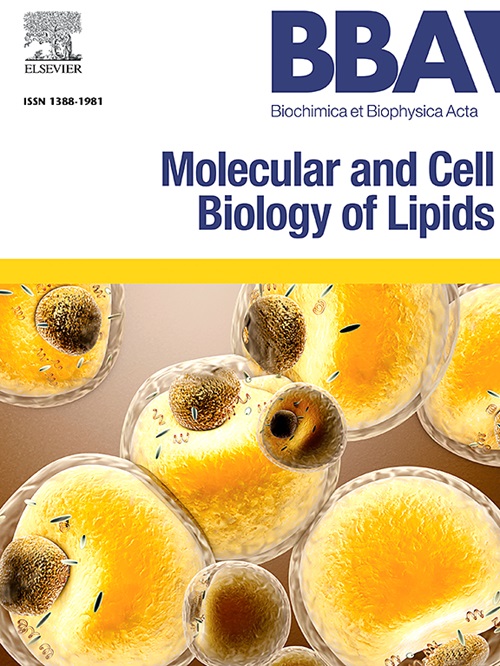Pain and functional limitations in knee osteoarthritis are reflected in the fatty acid composition of plasma extracellular vesicles
IF 3.3
2区 生物学
Q2 BIOCHEMISTRY & MOLECULAR BIOLOGY
Biochimica et biophysica acta. Molecular and cell biology of lipids
Pub Date : 2025-02-17
DOI:10.1016/j.bbalip.2025.159602
引用次数: 0
Abstract
This study investigated relationships between fatty acid (FA) profiles of extracellular vesicles (EVs) and cartilage degradation, functional limitations, pain, and psychological well-being in knee osteoarthritis (KOA). Fasting plasma was collected from controls (n = 10), end-stage KOA patients at baseline (n = 12) and at 3 and 12 months (n = 11 and 9) after joint replacement surgery, and from KOA synovial fluid (SF) at baseline (n = 10). EVs were isolated with the exoEasy Maxi Kit or size-exclusion chromatography, and EV FAs were analyzed with gas chromatography–mass spectrometry. Articular cartilage loss was determined by magnetic resonance imaging, and knee pain and function were assessed through questionnaires and physiatric and neuromuscular examinations. The associations of these data with EV FA proportions were tested with the univariate analysis of variance adjusted for age and body adiposity. Higher proportions of 16:1n-7, 18:1n-7, and total monounsaturated FAs in plasma EVs were associated with less severe KOA symptoms, while higher 24:1n-9, total saturated FAs, and ratios of arachidonic acid to long-chain n-3 polyunsaturated FAs (PUFAs) were linked to KOA pain, independent of age and body adiposity. In SF EVs, higher product/precursor ratios of n-6 PUFAs were associated with increased joint stiffness, and higher total dimethyl acetals were linked to physical disability. EV FAs emerged as significant indicators of knee pain and function. The results can be utilized to discover novel biomarkers for KOA and may have implications for targeted prevention and treatment of KOA symptoms by using EVs with a specific FA cargo.
膝关节骨关节炎的疼痛和功能限制反映在血浆细胞外囊泡的脂肪酸组成中。
本研究探讨了细胞外囊泡(ev)脂肪酸(FA)谱与膝关节骨关节炎(KOA)患者软骨退化、功能限制、疼痛和心理健康之间的关系。空腹血浆收集从控制(n = 10),晚期高雅患者基线(n = 12)和3和12 个月(n = 11和9)关节置换手术后,从高雅滑液(SF)基线(n = 10)。采用exoEasy Maxi Kit或尺寸排除色谱法分离EV,采用气相色谱-质谱法分析EV FAs。通过磁共振成像确定关节软骨损失,并通过问卷调查和物理和神经肌肉检查评估膝关节疼痛和功能。这些数据与EV FA比例的关联通过调整年龄和体脂的单变量方差分析进行检验。血浆EVs中较高比例的16:1n-7、18:1n-7和总单不饱和脂肪酸与较轻的KOA症状相关,而较高比例的24:1n-9、总饱和脂肪酸和花生四烯酸与长链n-3多不饱和脂肪酸(PUFAs)的比例与KOA疼痛相关,与年龄和身体肥胖无关。在SF电动汽车中,较高的n-6 PUFAs产物/前体比与关节刚度增加有关,而较高的总二甲基缩醛与身体残疾有关。EV FAs是膝关节疼痛和功能的重要指标。该结果可用于发现KOA的新型生物标志物,并可能对使用具有特定FA货物的ev有针对性地预防和治疗KOA症状具有指导意义。
本文章由计算机程序翻译,如有差异,请以英文原文为准。
求助全文
约1分钟内获得全文
求助全文
来源期刊
CiteScore
11.00
自引率
2.10%
发文量
109
审稿时长
53 days
期刊介绍:
BBA Molecular and Cell Biology of Lipids publishes papers on original research dealing with novel aspects of molecular genetics related to the lipidome, the biosynthesis of lipids, the role of lipids in cells and whole organisms, the regulation of lipid metabolism and function, and lipidomics in all organisms. Manuscripts should significantly advance the understanding of the molecular mechanisms underlying biological processes in which lipids are involved. Papers detailing novel methodology must report significant biochemical, molecular, or functional insight in the area of lipids.

 求助内容:
求助内容: 应助结果提醒方式:
应助结果提醒方式:


